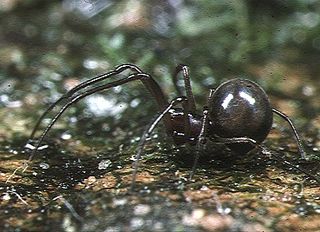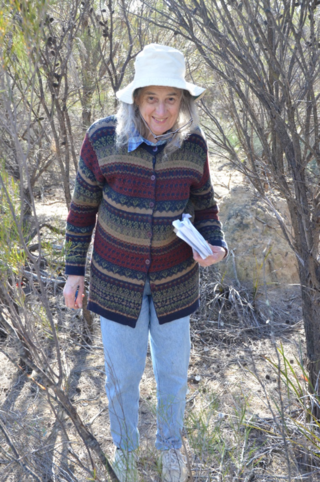Related Research Articles

Migidae, also known as tree trapdoor spiders, is a family of spiders with about 100 species in eleven genera. They are small to large spiders with little to no hair and build burrows with a trapdoor. Some species live in tree fern stems. They have a Gondwanan distribution, found almost exclusively on the Southern Hemisphere, occurring in South America, Africa, Madagascar, Australia, New Zealand and New Caledonia.

Anapidae is a family of rather small spiders with 232 described species in 58 genera. It includes the former family Micropholcommatidae as the subfamily Micropholcommatinae, and the former family Holarchaeidae. Most species are less than 2 millimetres (0.079 in) long.

Archaeidae, also known as assassin spiders and pelican spiders, is a spider family with about ninety described species in five genera. It contains small spiders, ranging from 2 to 8 millimetres long, that prey exclusively on other spiders. They are unusual in that they have "necks", ranging from long and slender to short and fat. The name "pelican spider" refers to these elongated jaws and necks used to catch their prey. Living species of Archaeidae occur in South Africa, Madagascar and Australia, with the sister family Mecysmaucheniidae occurring in southern South America and New Zealand.
Cataxia is a genus of Australian armored trapdoor spiders that was first described by William Joseph Rainbow in 1914.
Euoplos is a genus of Australian armored trapdoor spiders that was first described by William Joseph Rainbow in 1914.

Zephyrarchaea is a genus of Australian assassin spiders first described by Michael Gordon Rix & Mark Harvey in 2012 for nine new species and two that were formerly placed in the genus Austrarchaea. The name is based on the Latin zephyrus, meaning "west wind", referring to the western distribution in Australia and a preference for windy, coastal habitats by some species. It has been encountered in Western Australia, Victoria and South Australia.
Bertmainius is a genus of spiders in the family Migidae. It was first described in 2015 by Mark Harvey, Barbara York Main, Michael Rix and Steven Cooper. As of 2017, it contains 7 species, all from Western Australia.
Moggridgea rainbowi, also called the Australian trapdoor spider, is a small spider endemic to Kangaroo Island in South Australia. The spider was first recorded in 1919.

Barbara Anne York Main was an Australian arachnologist and adjunct professor at the University of Western Australia. The author of four books and over 90 research papers, Main is recognised for her prolific work in establishing taxonomy for arachnids, personally describing 34 species and seven new genera. The BBC and ABC produced a film about her work, Lady of the Spiders, in 1981.
Aname aragog is a species of trapdoor spider in the family Anamidae. It is found in the Pilbara region of Western Australia. The specific epithet is in reference to the spider Aragog in J.K. Rowling's Harry Potter books.

Gaius is a genus of large mygalomorph spiders in the family Idiopidae. Erected in 1914 by William Joseph Rainbow, for much of its history the genus contained only one species, Gaius villosus. More species were added in 2018. All are endemic to Western Australia.
Eucanippe is a genus of Western Australian armored trapdoor spiders first described by Michael Gordon Rix, Robert J. Raven, Barbara York Main, S. E. Harrison, A. D. Austin, S. J. B. Cooper & Mark Stephen Harvey in 2017.

Zephyrarchaea vichickmani, the Central Highlands assassin spider, is a spider in the family Archaeidae. The species was first described by Michael G. Rix and Mark Harvey in 2012. It is endemic to Victoria, Australia.

Zephyrarchaea austini or the Kangaroo Island assassin spider is a species of Australian assassin spiders that is endemic to the north west of Kangaroo Island, South Australia. It was discovered in 2010, and described 2012 by Michael G. Rix and Mark Harvey, and named for Andy Austin.
Arbanitis phippsi is a spiny trapdoor spider in the Idiopidae family, which is found in New South Wales.
Cryptoforis is a genus of Australian armored trapdoor spiders. It was first described by J. D. Wilson, Robert Raven and Günter E. W. Schmidt in 2020, and it has only been found in Australia.
Arbanitis weigelorum is a species of armoured trap-door spider in the family Idiopidae, and is endemic to New South Wales.
Arbanitis wayorum is a species of armoured trap-door spider in the family Idiopidae, and is endemic to New South Wales.
Arbanitis mascordi is a species of armoured trap-door spider in the family Idiopidae, and is endemic to New South Wales.
Idiosoma castellum is a trapdoor spider in the Arbanitinae subfamily of the Idiopidae family. It was first described as Aganippe castellum by Barbara York Main in 1986. In 2017 Michael Rix and others transferred it to the genus, Idiosoma, to give the name Idiosoma castellum,.
References
- ↑ "Dr Michael Rix". www.qm.qld.gov.au. Retrieved 14 February 2020.
- ↑ "Michael Rix - Google Scholar Citations". scholar.google.com. Retrieved 14 February 2020.
- ↑ "Search for species author Rix", World Spider Catalog, Natural History Museum Bern, retrieved 29 October 2016
- ↑ "Search for genus author Rix", World Spider Catalog, Natural History Museum Bern, retrieved 29 October 2016
- ↑ Desmond, Rosemary (15 March 2003). "Species closes Gondwana gap". The Courier-Mail. Brisbane, Qld. p. 8.
- ↑ Pierre, Nicole (20 October 2019). "SPINNING WEB OF INTRIGUE". The Courier-Mail. Brisbane, Qld. p. 28.
- ↑ "Trapdoor spiders disappearing from Australian landscape". ScienceDaily. Retrieved 14 February 2020.
- ↑ Collard, Sarah (16 May 2018). "Rare WA 'armoured' spiders under threat from habitat destruction". ABC News. Retrieved 14 February 2020.
- ↑ Kilvert, Nick (18 January 2020). "Ancient 'assassin' may have been wiped out by Kangaroo Island fires". ABC News. Retrieved 14 February 2020.